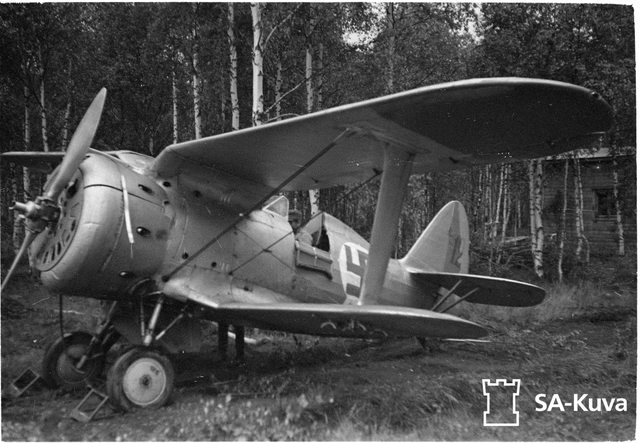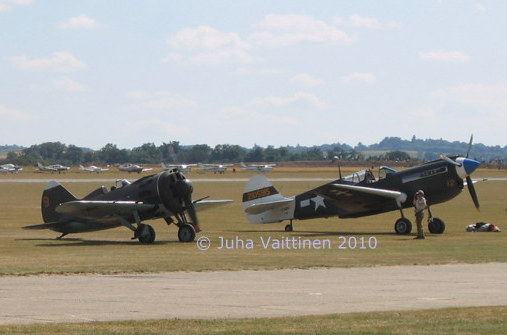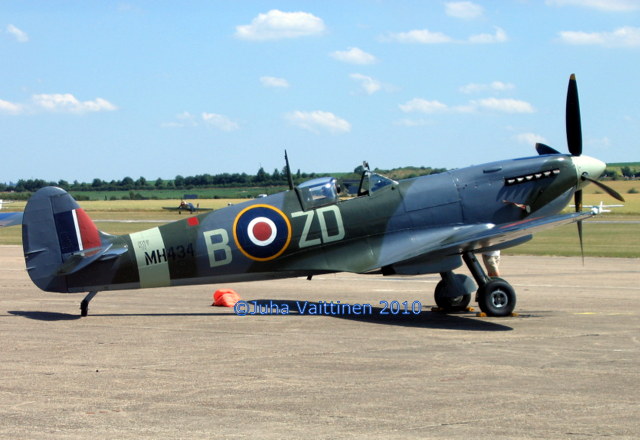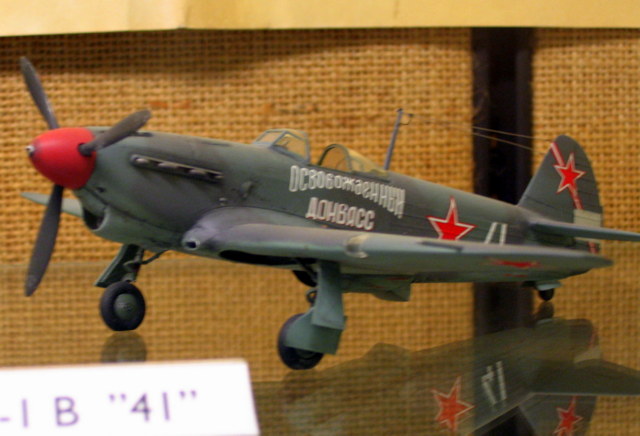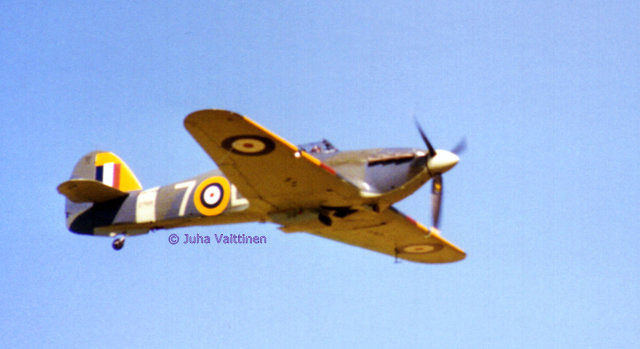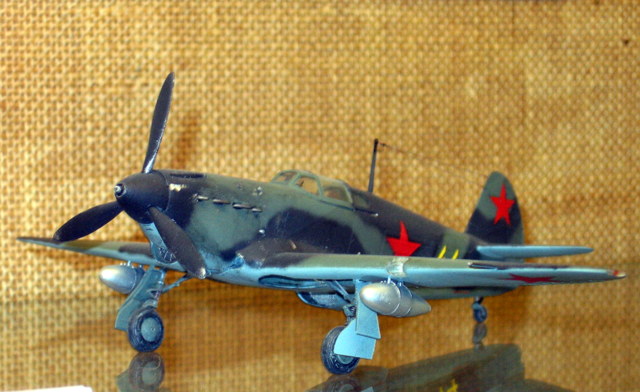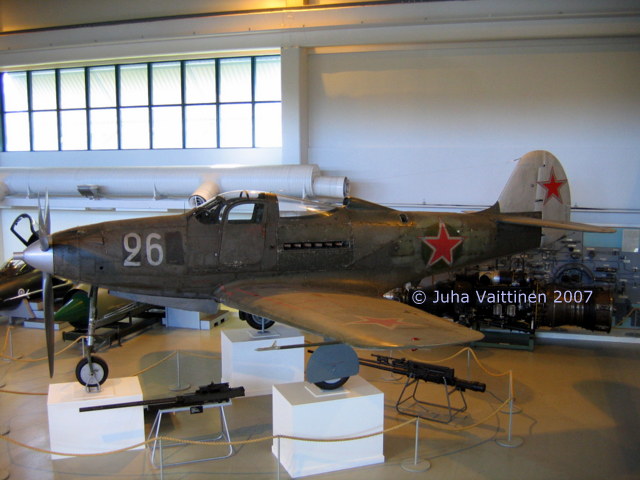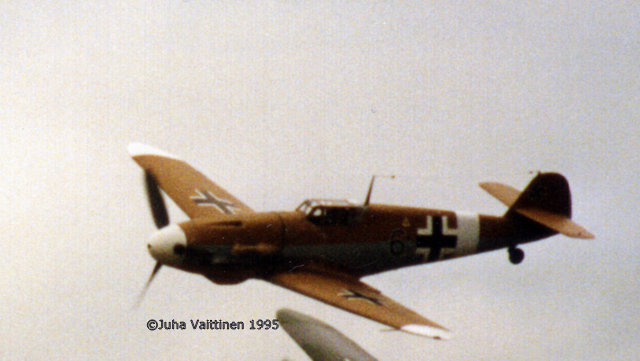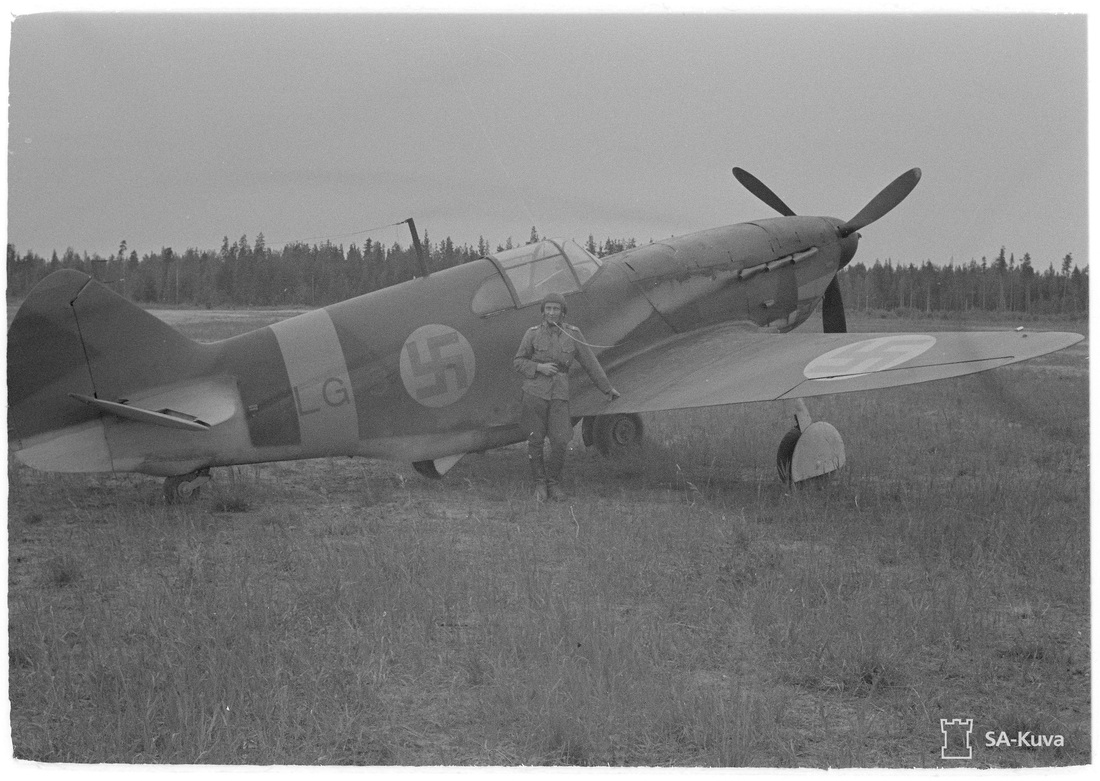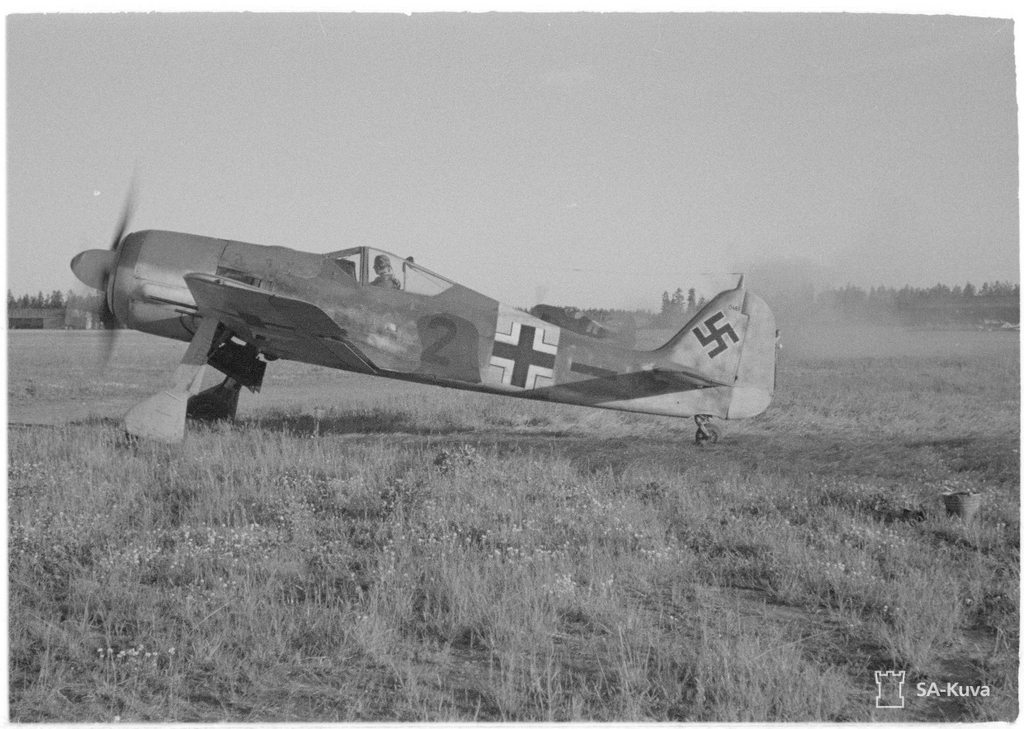Results of the Soviet turn time tests
|
I personally think that vertical maneuverability was more important than horizontal for the WWII fighters but the latter was also important and while climb rate info is usually easily available on WWII fighters, turn time tests are harder to find. So I decided to publish info on some results of the Soviet turning tests. I have put them together from what I have found from various secondary sources and from some scans which friendly people have shared with me over the years. I have made comments on some, mostly adding how Finns saw the things. Only info which clearly bothered me is that of LaGG-3 series 28, much better than Finns thought it was. But Lavochkin's fighters varied much because the quality of their finish varied. Special thanks for the extra info provided by VG-33, Kurfürst and Claidemore on the wwiiaircraft site.
Soviet tests were flown at 1000m, so they tended to favour Soviet fighters, most of which were optimized for low and medium altitude combat. The exception was MiG-3 which was designed as a high altitude interceptor. The times are the time needed for a 360deg horizontal turn without a height loss. When the time of the turn is given xx – yy secs, there were different times for turning left and right. AND one must remember that in a turning combat much depended on pilot's skills, to fly a plane to its limits one needs skills and knowledge. Also the turning ability was only one factor in a turning fight, e.g. a skillfull pilot in a plane with better rate of roll might well beat a pilot in a better turning plane by using barrel roll. Polikarpov I-15 (1934, 1,415 kg, 480hp M-22 - Soviet version of Bristol Jupiter, 2 or 4 x 7,62mm PV-1 mgs): 8 - 8.5 secs Polikarpov I-15bis (1937, 1,640 kg, 764 hp/740 hp Shvetsov M-25V, 4 x 7,62mm PV-1 mgs): 10.5 secs Polikarpov I-153 "Chaika" (1939, 1,680 kg, 764 hp/740 hp Shvetsov M-25V, 4 x 7,62mm ShKAS mgs): 11.4 - 12.4 secs Polikarpov I-153 "Chaika" (1939, 1,762 kg, 986 hp/789 hp Shvetsov M-62, 4 x 7,62mm ShKAS mgs): 11.4 - 12.4 secs Finnish tests 12 sec, radius 110m, maybe the most feared opponent to Fokker D. XXI pilots during Winter War, FiAF used war booty I-153s as a frontline a/c to autumn 44, during later part of the Continuation War (25 Jun 41 – 4 Sept 44) as recon fighter, last kill on 29 July 44, a P-39 from 773 IAP. Polikarpov I-153 "Chaika" (1940, 1,902 kg, 1085 hp/887 hp Shvetsov M-63, 4 x 7,62mm ShKAS mgs): 14 secs Polikarpov I-16 tip 29 (1940, 1,966 kg, 1085 hp/887 hp Shvetsov M-63, 2 x 7.62mm ShKAS + 1 x 12.7mm UBS): 16-17 secs Polikarpov I-16 tip 10 (1938, 1,716 kg, 764 hp/740 hp Shvetsov M-25V, 4 x 7.62mm mgs): 16-18 or 16.5 secs Yakovlev Yak-9 (1943, 2,873 kg, 1,193 hp/ 1,163 hp Klimov M-105PF, 1x20mm ShVAK + 1x12.7mm UBS): 17 secs or 16 - 17 secs or 17 - 18 secs Finns thought that Yak-9 was very manoeuvrable, there are many comments like that in the FiAF Bf 109G pilots’ combat reports Polikarpov I-16 tip 28 (1939 - 40, 1,988 kg, 1085 hp/887 hp Shvetsov M-63, 2 x 7.62mm ShKAS + 2 x 20mm ShVAK): 17 - 19 secs Yakovlev Yak 1B (1942, 2,884 kg, 1,193 hp/ 1,163 hp Klimov M-105PF, 1 x 20mm ShVAK + 1 x 12.7mm UBS): 17 - 19secs or 19 secs depending the source. Supermarine Spitfire F Mk IX (1944, 3,292 kg, 1,275 hp/1,380 hp Merlin 61, 2 x 20mm + 4 x 7.7mm): 17.5 secs Bell P-39D-2 (1,350 hp/1,135 hp Allison V-1710-63, 1x37mm+2x12.7mm+4x7.62mm): 17.7-18.7 secs Curtiss P-40C (3,390 kg, 1,055 hp Allison V-1710-33, 2x12.7mm+4x7.62mm): 18.0 secs mid Yakovlev Yak-1 (1942, 2,900 kg, 1,193 hp/ 1,163 hp Klimov M-105PF, 1 x 20mm ShVAK + 1 x 12.7mm UBS): 18-19 secs Yakovlev Yak-9T (1943, 3,025 kg, 1,193 hp/ 1,163 hp Klimov M-105PF, 1x37mm NS-37 + 1 x 12.7mm UBS): 18-19 secs. Lavochkin LaGG-3 series 66 (1943, 2,990 kg, 1,193 hp/ 1,163 hp Klimov M-105PF, 1 x 20mm ShVAK + 1 x 12.7mm UBS): 18 - 19secs or 19 secs depending the source. this lightened version was IMHO better than series 28, a LW top ace, IIRC Barkhorn, told later that hardest fight he ever fought was a long duel against a LaGG-3 from a GIAP in 1943/44, which ended when both disengaged simultaneously, so late over the Southern sector IMHO the LaGG must have been the lightened series 66 a/c. Bell P-400/Airacobra Mk. I (1942, 3,556 kg, 1,150 hp V-1710-35, 1x20mm + 2x12.7mm + 4 x 7.62mm) 18.2 secs Bell P-400/Airacobra Mk. I (lightened) (1942, 3,324 kg, 1,150 hp V-1710-35, 1 x 20mm + 2 x 12.7mm): 18.2 secs Supermarine Spitfire LF. Mk IXE (1945, 3,351 kg, 1,320 hp/1,580 hp Merlin 66, 2 x 20mm + 2 x 12.7mm): 18.5 secs Bell P-39L-1-BE (1943, 3,616 kg, 1,325 hp V-1710-63, 1x37mm+2x12.7mm+4x7.62mm): 18.5 secs Supermarine Spitfire Mk VB (1943, 2,920 kg, 1,130 hp/1,166 hp Merlin 46, 2 x 20mm + 4 x 7.7mm): 18.8 secs Curtiss P-40M-5-CU (1943, 3,958 kg, 1,200 hp/1,125 hp V-1710-81, 6x12.7mm): 18.8 secs Supermarine Spitfire HF. Mk IX (1945, 3,338 kg, 1,475 hp Merlin 70, 2 x 20mm + 2 x 12.7mm): 19 secs Lavochkin LaGG-3 series 28 (1942, 3,055 kg, 1,085 hp/1,035 hp Klimov M-105PA, 1 x 20mm ShVAK + 1 x 12.7mm UBS): 19 secs Finns concluded that LaGG-3 turned more or less as well as 109G. When Finns tested a LaGG-3 against Hawk 75A, LeLv 32 (Fighter Wing/Jagdgruppe) used both types in combat, conclusion was that if at the beginning of a mock combat LaGG-3 was behind Hawk 75A after only 1½ turns situation was reversed. Lavochkin La-5 (1943, 3,208 kg, 1,676 hp/1,311 hp Shvetsov M-82, 2 x 20mm ShVAK): 19 secs Bell P-39D (3,556 kg, 1,150hp Allison V-1710-35, 1x37mm+2x12.7mm+4x7.62mm): 19 secs Bell P-39N-1 (1,420 hp/1,200 hp Allison V-1710-85, 1x37mm+2x12,7mm+4x7.62mm): 19 secs From the report of FiAF 3./HLeLv 34 on the actions during the hectic summer 44. “AC (P-39) is more or less as good as La-5 (at this stage means La-5Fs and FNs) but maybe less manoeuvrable.” Yakovlev Yak-3 (1943, 2,697 kg, 1,272 hp/1,223 hp Klimov VK-105PF-2, 1x20mm + 2x12.7mm): 19 secs Hawker Hurricane IIA (1941, 3,170 kg, 1,280 hp R-R Merlin XX, Vokes filter, 8x7.7mm Browning): 19-20 secs Bell P-39Q-25-BE (1944, 3,547 kg, 1,420 hp/1,200 hp Allison V-1710-85, 1x37mm+2x12.7mm so without gunpods): 19-20 secs Yakovlev Yak-1 (1941, 2,934 kg, 1,085 hp/1,035 hp Klimov M-105PA, 1 x 20mm ShVAK + 2 x 7.62mm ShKAS): 19-20 secs Yakovlev Yak-1 (1942, 2,917 kg, 1,193 hp/ 1,163 hp Klimov M-105PF, 1x20mm ShVAK + 2 x 7.62mm ShKAS): 19-20 secs Yakovlev Yak-7B (1942, 3,005 kg, 1,193 hp/ 1,163 hp Klimov M-105PF, 1x20mm ShVAK + 2 x 12.7mm UBS): 19-20 secs Finns misidentified some Yak-7Bs as Spitfires, they were told that they might meet Spitfires, and thought that these didn’t live up their high reputation Yakovlev Yak-9D: (1943, 3,117 kg, 1,193 hp/ 1,163 hp Klimov M-105PF, 1x20mm ShVAK + 1 x 12.7mm UBS): 19-20 secs Yakovlev Yak-9M: (1944, 3,095 kg, 1,193 hp/ 1,163 hp Klimov VK-105PF, 1x20mm ShVAK + 1 x 12.7mm UBS): 19-20 secs Lavochkin La-5FN (1943, 3,305 kg, 1,825 hp/1,410 hp Shvetsov ASh-82FN, 2 x 20mm ShVAK): 19 or 19.5 secs, depending on the source. Finns thought that La-5F/FN was a bit better turner than 109G at low level. It was also the most dangerous opponent of FiAF Bf 109Gs during the heavy fighting in summer 44, even if one cannot find so many glowing appraisal on La-5 than on Yak-9 in FiAF 109G pilots’ combat reports Curtiss P-40E-1-CU (1942, 3,840 kg, 1,150 hp Allison V-1710-39, 6x12.7mm): 19.2 secs mid Bell P-39Q (1943, 3,495 kg, 1,420 hp/1,200 hp Allison V-1710-85, 1x37mm+4x12.7mm so with gunpods): 19.5 secs the subversion is not given, but the weight given is some 25kg lighter than the grossweight of Q-15-BE, see below, maybe Q-5-BE or a lightened plane. Yakovlev Yak-1 (1942 Winter variant, heavier due to insulation, heating ducts etc): 19.5 secs Messerschmitt Bf 109F-4 (2,902 kg, 1,331 hp/1,183 hp DB601E, 1x20mm MG 151/20 + 2x7.92mm MG 17): 19.6 - 20.5 secs Soviet max speed for the aircraft (624km/h at 6,500m) is on slow side, so maybe it had some problems Messerschmitt Bf109F-2 (2,780 kg, 1,144 hp DB 601N, 1x15mm MG 151 + 2x7.92mm MG 17): 19.6 secs (some sources 19.8) -20.5 NII Hawker Hurricane IIC (1943, 3,455 kg, 1,319 hp Merlin XX, 4 x 20mm): 20 secs Lavochkin LaGG-3 series 4 - 8, (3,280 kg, 1,085 hp/1,035 hp Klimov M-105PA, 1 x 20mm ShVAK + 1 x 12.7mm UBS + 2 x 7.62mm ShKAS): 20 secs Finnish tested a war booty LaGG-3 series 4 (identification sign LG-1) which was modified with wing slots. The three test pilots got the average of 25 secs with 40km/h speed loss at 2,000 m (the lowest altitude used in those tests), the best result was 23 secs at 2,000 m. The same plane shot down a Soviet LaGG-3 from 415 IAP on 16 Feb 44 after fairly long turning fight. The fight began as an head on meeting with 2 escorting LaGG-3s against the LG-1. After a while after an head on pass one of the Soviet LaGGs disengaged but the other continued the turning fight until it was hit after which it tried disengage but the FiAF pilot followed and shot it down. So Finns were not altogether hopeless while flying early LaGG- 3s, there were some other contacts with FiAF and Soviet LaGG-3s which ended without losses on either side. IMHO in early 1944 Soviet LaGG-3s should have been at least series 28 planes or later. Lavochkin La-5F (1943, 3,207 kg, 1,676 hp/1,311 hp Shvetsov M-82F; 2 x 20mm ShVAK): 20 secs Finns thought that La-5F/FN was a bit better turner than 109G at low level, the high back La-5, which Finns called LaGG-5, was more or less equal to 109G-2 in low-speed turning fight at low level Yakovlev Yak-9U (1944, 3,260 kg, 1,479 hp/1,430 hp Klimov VK-107A, 1x20mm ShVAK + 2x12.7mm UBS): 20 secs Bell P-39Q-10-BE (1943, 3,570 kg, 1,420 hp/1,200 hp Allison V-1710-85, 1x37mm + 4x12.7mm so with gunpods): 20-21 secs From the report of FiAF 3./HLeLv 34 on the actions during the hectic summer 44. “AC (P-39) is more or less as good as La-5 (at this stage means La-5Fs and FNs) but maybe less manoeuvrable.” Lavochkin La-7 (1944, 3,232 kg, 1,824 hp/1,449 hp Shvetsov ASh-82FN, 2 x 20mm ShVAK): 20 - 21 secs or 20.5 secs Messerschmitt Bf 109G-2 (1942, 3,023 kg, 1,454 hp/1,233 hp DB 605A-1, 1 x 20mm MG 151 + 2 x 7.92mm MG 17): 20-21.5 secs, middle 21 secs NII Finnish tests, also at 1,000m, 1,3 ata, sustained 22 secs, speed 360 km/h 3G Messerschmitt Bf 109G-4 (1943, 1,454 hp/1,233 hp DB 605A-1, 1 x 20mm MG 151 + 2 x 7.92mm MG 17): 20.5-21 secs Hawker Hurricane IIB (1942, 3,352 kg, 1,319 hp Merlin XX, 2 x 20mm ShVAK + 2 x 12.7mm + 6 x RS-82 rockets): 20.5 secs Bell P-63A-10-BE (1945, 3,822 kg, 1,325 hp V-1710-93, 1x37mm + 2x12.7mm): 20.5 secs Lavochkin LaGG-3 series 29 and 32 (3,150 kg, 1,193 hp/ 1,163 hp Klimov M-105PF, 1 x 20mm ShVAK + 1 x 12.7mm UBS): 21 secs or 22 secs depending the source. When Finns tested a LaGG-3, FiAF LG-3 was 35th serie aircraft, that Serie was the first with leading edge slats, against Hawk 75A, LeLv 32 (Fighter Wing/Jagdgruppe) used both in combat, conclusion was that if at the beginning LaGG-3 was behind Hawk 75A after only 1½ turns situation was reversed. Yakovlev Yak-7A (1942, 2,935 kg, 1,085 hp/1,035 hp Klimov M-105PA, 1 x 20mm ShVAK + 2 x 7.62mm ShKAS): 21-22 secs Focke-Wulf FW 190A-5 (1942, 4,070 kg, 1,558 hp/1,440 hp BMW 801 D-2): 21 - 22 secs Focke-Wulf FW 190A-8 (1944, 3,986 kg, 1,558 hp/1,440 hp BMW 801 D-2, 2x20mm + 2x13mm): 21 - 22 secs without outer wing cannon and also otherwise lightened, because according to German documents weight should have been 4,272 - 4,395kg w/o a drop tank, different docus give different weights and appr. 4,100kg without outer wing cannon) Hawker Hurricane IID (1944, 3,650 kg, 1,319 hp Merlin XX, 2 x 40mm [should also have 2 x 7.7mm, removed or forgotten]): 22 secs Lavochkin LaGG-3 series 1 - 3 (3,346 kg, 1,085 hp/1,035 hp Klimov M-105P, 3 x 12.7mm UB + 2 x 7.62mm ShKAS): 22 secs Lavochkin LaGG-3-37 (3,363 kg, 1,193 hp/ 1,163 hp Klimov M-105PF, Armed with a 37mm Sh-37 cannon and 1x12,7mm UBS). Also had leading edge slats: 22 secs Finns met these a/c in summer 44, one Soviet regiment equipped with these and Yak-9s was transferred from VVS Black Sea Fleet to VVS Baltic Fleet to reinforce Soviet attack forces, but I recall only comments on their good tactics and unusual camo from Finnish combat reports. Focke-Wulf FW 190A-4 (3,989 kg, 1,706 hp/1,341 hp BMW801D, 4x20mm + 2x7.92mm): 22 - 23 secs NII-VVS, 23 - 24 secs LII-NKAP Focke-Wulf FW 190D-9 (4,197kg, 1,755 hp Jumo 213A, 2x20mm + 2x13mm): 22 - 23 secs, max speed achieved was 624km/h. Very near the German test results with the 6th series production Fw 190D-9 at Rechlin test center, which were at 3,000 rpm max. speeds 520 to 530 km/h at sea level and 625 and 635km/h at 6,500m (about full throttle height, depending on engine adjustment). 3,000rpm means Steig- und Kampfleistung (climb and combat power) and with 3,250 rpm, speeds reached 540 and 550 km/h at sea level and 645 and 655 km/h at 6,600m. This with Start- und Notleistung (Take-off and emergency power) with B4/87oct. fuel. Take-off weight was 4,350kg. Soviets didn't use MW50 or C3/96oct fuel in their 190D-9 tests. According to Focke-Wulf the top speed at Start u. Notleistung with B4 was 568 km/h at SL and 680 km/h at 6,600m. Messerschmitt Bf 109G-2/R6 (1942, 3,235 kg, 1,454 hp/1,233 hp DB 605A-1, 3 x 20mm MG 151 + 2 x 7.92mm MG 17): 22.6 - 22.8 secs Lavochkin La-5 (1942, 3,360 kg, 1,676 hp/1,311 hp Shvetsov M-82, 2 x 20mm ShVAK): 22.6 secs North American Mustang Mk I (1942, 3,884 kg, 1,150 hp Allison V1710-F3R, 4x12.7mm + 4x7.62mm): 23 secs. Soviet tested one of those sent from GB (AG348 ) and the max. speed at 4,600m 587km/h, the designation used in some Soviet documents, NA-73, and the engine sub-type indicated that it was not P-51A but XP-51 in USAAF parlance. British A&AEE tests in spring 42 (AG351) 595km/h at 4,572m, so almost the same speed. MiG-3 (1941, 3,350 kg, 1,331 hp / 1,183 hp Mikulin AM-35A, 1x12.7mm UB + 2x7.62 mm ShKAS): 23 secs Finns: at lower level not very manoeuvrable on horizontal plane) Messerschmitt Bf 109E-3 (1940, 2 x 20mm MG FF + 2 x 7.92mm MG 17): 23-26 secs with 1.33 ata, max 5 min power setting The supercharger seemed to have malfunctioned at low level, which was very important for these tests made at 1000m. German specs give 18.92 sec for a sustained turn at SL for the Emil, at 5 min rating, w/o using the 1-min special low-alt augmented rating. British tests gave 25 sec but the altitude was 12,000 ft, means 3,658m, so at higher altitude and so it should have taken a little longer than at 1,000m. British didn't notice any measureable difference between turning left or right.) Lavochkin LaGG-3 series 23 (3,100 kg, 1,085 hp/1,035 hp Klimov M-105PA, 1 x 20mm ShVAK + 1 x 12.7mm UBS + 6 x 82mm RS-82 rockets): 26 secs Republic P-47D-10-RE (1944, 5,961 kg, 2,000 hp R-2800-63, 6(8)x12.7mm, 661km/h at 8,500m): 26 secs Yakovlev Yak-9DD (1944, 3,387 kg, 1,193 hp/ 1,163 hp Klimov VK-105PF, 1x20mm ShVAK + 1 x 12.7mm UBS): 26 secs Messerschmitt Bf 109E-3 (1940, 2,605 kg, 2 x 20mm MG FF + 2 x 7.92mm MG 17): 26.5-29 secs at 1.26 ata The supercharger seemed to have malfunctioned at low level, which was very important for these tests made at 1,000m. German specs give 18.92 secs for a sustained turn at SL for the Emil, at 5 min rating, w/o using the 1-min special low-alt augmented rating. Republic P-47D in 1945: 27-28 secs Messerschmitt Bf 110C-4 (1940, 6,510 kg, 2 x 20mm MG FF + 4 x 7.92mm MG 17 + 1 x 7.92mm MG 15): within 30 secs Some of the sources: Flugzeuge, Flugzeugausrûstung und Waffen der sowjetischen Luftwaffe. Heft II Flugzeugausrûstung und Waffen Stand: Mai 1942 Nr. 1500/42 (GL/A-Rü) Several scans from Russian literature on those tests given by some friends. Carl-Fredrik Geust & Gennadiy Petrov, Red Stars Vol. 4 Lend-lease aircraft in Russia (2002) Yefim Gordon, Lavochkin's Piston-Engined Fighters (2003) Yefim Gordon, Soviet Air Power in World War 2 (2008) Yefim Gordon and A. Dexter, "Polikarpov Biplane Fighter Variants" in Wings of Fame Volume 17 (1999) Yefim Gordon and Keith Dexter, Polikarpov's I-16 Fighter Its Forerunners and Progeny (2001) Yefim Gordon and Dmitri Khazanov, Soviet Combat Aircraft of the Second World War Volume One: Single-Engined Fighters (1998) Yefim Gordon and Sergey Komissarov, US Aircraft in the Soviet Union and Russia (2008) Yefim Gordon and Boris Rybak, "Under Red Star" in FlyPast August 1997 pp. 83 - 85 and September 1997 pp. 28 - 30 Reciprocating Engine Characteristics [US] Ray Wagner, American Combat Planes. New Revised Edition. (1968) http://www.ww2aircraft.net/forum/aviation/soviet-turning-time-tests-comments-please-19130.html http://www.wio.ru/tacftr/ww2t.htm http://www.airpages.ru/uk/spit_12.shtml http://www.spitfireperformance.com/spit1vrs109e.html http://www.wwiiaircraftperformance.org/mustang/mustang-I.html http://www.wwiiaircraftperformance.org/fw190/fw190d9test.html http://www.p40warhawk.com/Variants/Tomahawk.htm |
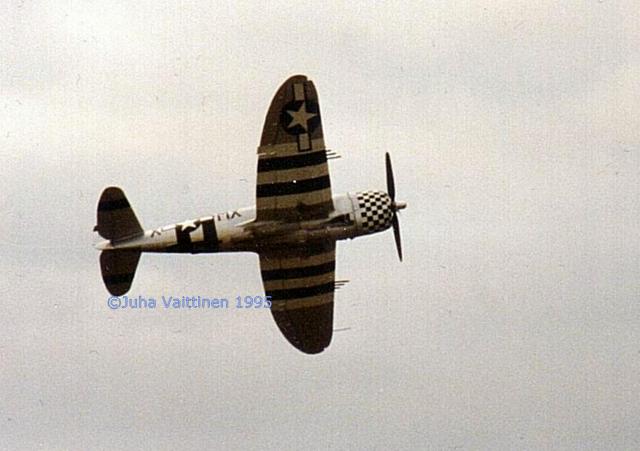
The Republic P-47D of The Fighter Collection in 1995. P-47D was an anti-thesis to the Soviet idea of a fighter, being big, heavy high-altitude fighter with powerful wing armament. Soviet Union got 196 P-47Ds, 7 other were lost during delivery. They served Soviets with the PVO (the air defence organisation) and with the Naval Aviation.
|
